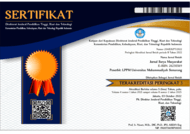Teknologi Budidaya Maggot untuk Kelompok Pembudidaya Ikan “Panle Bersaudara”, Desa Danda Jaya, Barito Kuala
(1) Program Studi Akuakultur Fakultas Perikanan dan Kelautan Universitas Lambung Mangkurat, Banjarbaru
(2) Program Studi Akuakultur Fakultas Perikanan dan Kelautan Universitas Lambung Mangkurat, Banjarbaru
(3) Program Studi Magister Ilmu Perikanan Program Pascasarjana Universitas Lambung Mangkurat, Banjarbaru
(4) Program Studi Akuakultur Fakultas Perikanan dan Kelautan Universitas Lambung Mangkurat, Banjarbaru
(*) Corresponding Author
Abstract
Community Service with the Community Partnership Program (PKM) scheme was carried out for the "Panle Brothers" Fish Cultivator Group (Pokdakan), Danda Jaya Village, Rantau Badauh District, Barito Kuala Regency. Pokdakan cultivates catfish and catfish, with a cultivated fish pond area of only 0.2 ha, and the size of the fish pond plots varying from 25 – 100 m2. Productivity is low, because Pokdakan is still very dependent on commercial feed which is very expensive with a small profit margin. Businesses for making independent feed have begun to be carried out using local ingredients, but the use of animal ingredients still relies on fish meal. The solution to overcome this problem is to carry out the dissemination of maggot cultivation technology from Black Soldier Fly (BSF) flies. This is the right and strategic step to substitute fish meal, because the protein contained in maggots is equivalent to or even more than fish meal. Research results state that maggots contain between 40-60% protein so that using maggots in feed formulations, even if given directly fresh to carnivorous fish such as catfish and catfish, can save production costs of up to 40%. Dissemination of this technology is delivered using theoretical explanations, demonstrations, training and intensive assistance during activities. The results obtained showed that the group of cultivators were very enthusiastic in accepting the technology presented, there was an increase in knowledge of 328.57% and an increase in skills of 541.67% regarding maggot cultivation. The supporting factor for this activity is that the Pokdakan group shows great interest and motivation in this technology. The inhibiting factor is that very hot weather causes maggot growth to be less than optimal.
Keywords
Full Text:
PDFReferences
Afrianto, I. E., & Liviawaty, I. E. (2005). Pakan Ikan dan Perkembangannya. Kanisius.
Rachmawati, R., Buchori, D., Hidayat, P., Hem, S., & Fahmi, M. R. (2010). Perkembangan dan kandungan nutrisi larva Hermetia illucens (Linnaeus)(Diptera: Stratiomyidae) pada bungkil kelapa sawit. Jurnal Entomologi Indonesia, 7(1), 28-28.
Rumondor, G., Maaruf, K., Wolayan, F. R., Tulung, Y. R. L., & Wolayan, F. R. (2016). Pengaruh penggantian tepung ikan dengan tepung maggot black soldier (Hermetia illucens) dalam ransum terhadap persentase karkas dan lemak abdomen broiler. Zootec, 36(1), 131- 138.
Article Metrics
Abstract view : 119 timesPDF - 15 times
DOI: https://doi.org/10.26714/jsm.7.1.2024.8-13
Refbacks
- There are currently no refbacks.
Copyright (c) 2024 Jurnal Surya Masyarakat

Jurnal Surya Masyarakat (JSM) is licensed under Creative Commons Attribution-NonCommercial-NoDerivatives 4.0
------------------------------------------------------------------------------------------------------------------------
Jurnal Surya Masyarakat (JSM)
p-ISSN: 2623-0364; e-ISSN: 2623-0569
Published by: Lembaga Penelitian dan Pengabdian Masyarakat (LPPM) Universitas Muhammadiyah Semarang



.jpg)







.jpg)